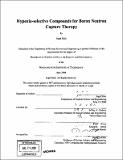| dc.contributor.advisor | Jeffrey A. Coderre. | en_US |
| dc.contributor.author | Shah, Jungal (Jugal Kaushik) | en_US |
| dc.contributor.other | Massachusetts Institute of Technology. Dept. of Nuclear Science and Engineering. | en_US |
| dc.date.accessioned | 2009-03-16T19:48:27Z | |
| dc.date.available | 2009-03-16T19:48:27Z | |
| dc.date.issued | 2008 | en_US |
| dc.identifier.uri | http://hdl.handle.net/1721.1/44829 | |
| dc.description | Thesis (S.B.)--Massachusetts Institute of Technology, Dept. of Nuclear Science and Engineering, 2008. | en_US |
| dc.description | "June 2008." | en_US |
| dc.description | Includes bibliographical references. | en_US |
| dc.description.abstract | Boron neutron capture therapy (BNCT) is a biochemically targeted form of radiotherapy for cancer. In BNCT, a compound labeled with the stable isotope boron-10 is systemically administered, and tumor cells selectively uptake the boron-10 containing compound at higher concentrations than normal cells. A general problem with the tumor seeking compounds is that drug delivery is dependent upon sufficient vascularization within the tumor. To investigate the possibility of delivering boron to hypoxic regions of tumor, a new boronated nitroimidazole delivery agent has been synthesized as a carrier of boron-10 for BNCT. It is expected that this will be used in combination with the existing boron carrier boronophenylalanine-fructose to treat solid tumors. An immunohistochemical protocol to visualize hypoxia was tested and refined to confirm the suitability of two tumor models established in the lab for hypoxia related uptake studies. The immunohistochemical protocol is used to detect pimonidazole, which localizes at hypoxic regions in tissue and is the parent compound for the new hypoxia-selective boron carrier. The protocol was used to test and confirm the suitability of a hypoxic in vivo tumor model. Two tumor lines were tested: SCCVII squamous cell carcinoma and EMT-6 murine mammary carcinoma. Both exhibited hypoxia. Finally, quantitative studies using Inductive Coupled Plasma Atomic Emission Spectrum demonstrated that the synthesized boronated nitroimidazole reaches suitable concentrations in SCCVII and F98 tumor. Future therapeutic studies are required to empirically confirm the effectiveness of this compound. | en_US |
| dc.description.statementofresponsibility | by Jugal Shah. | en_US |
| dc.format.extent | 39 p. | en_US |
| dc.language.iso | eng | en_US |
| dc.publisher | Massachusetts Institute of Technology | en_US |
| dc.rights | M.I.T. theses are protected by
copyright. They may be viewed from this source for any purpose, but
reproduction or distribution in any format is prohibited without written
permission. See provided URL for inquiries about permission. | en_US |
| dc.rights.uri | http://dspace.mit.edu/handle/1721.1/7582 | en_US |
| dc.subject | Nuclear Science and Engineering. | en_US |
| dc.title | Hypoxia-selective compounds for boron neutron capture therapy | en_US |
| dc.type | Thesis | en_US |
| dc.description.degree | S.B. | en_US |
| dc.contributor.department | Massachusetts Institute of Technology. Department of Nuclear Science and Engineering | |
| dc.identifier.oclc | 301562235 | en_US |
